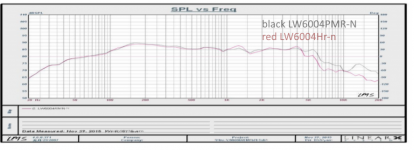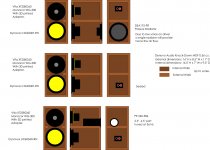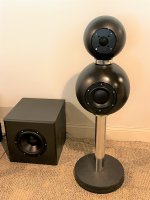I think vented will offer you better power handling, just stating what Eric did. The Xmax use at lower ranges is not congenial, and the port will take over for the stressful stuff.
The newer models have a lot more svelte frame, and the older ones were darn near 0.25" thick steel/aluminum slabs. They definitely weighed a lot more. It is possible that the extra metal wicked heat away more efficiently, but something tells me that the lower PE is really only just a more conservative number. 3" VC handle a lot of power in general.
ChrisABC- it was a very remarkable 5" woofer in its capabilities, and in league with the SS 8530K00, W5-1138, HiVi D5.8 and D5G, and Peerless SDS 5" in terms of low-end reach. Not many 5" woofers can do that. In fact- the ones above may be the entire list.
Doing that AND reaching high enough to reasonably meet a tweeter in a 2-way cuts that list in half.
Later,
Wolf
The newer models have a lot more svelte frame, and the older ones were darn near 0.25" thick steel/aluminum slabs. They definitely weighed a lot more. It is possible that the extra metal wicked heat away more efficiently, but something tells me that the lower PE is really only just a more conservative number. 3" VC handle a lot of power in general.
ChrisABC- it was a very remarkable 5" woofer in its capabilities, and in league with the SS 8530K00, W5-1138, HiVi D5.8 and D5G, and Peerless SDS 5" in terms of low-end reach. Not many 5" woofers can do that. In fact- the ones above may be the entire list.
Doing that AND reaching high enough to reasonably meet a tweeter in a 2-way cuts that list in half.
Later,
Wolf
LW6004HR-N winisd driver definition
I like how the vented looks better. Due to size constrains, I will tune it to 55 Hz. Attached are some drawings of the design. After looking at the sims, I like the vented the most.
Also I included the winisd driver definition for the LW6004HR-N.
'Simplicity' by Eric Levenchuck (brkitup) over on PE is really nice. It has a crossover design that I can use as a reference. I may try to test the sealed before I drill the ports. Overall this is my first two way and I am interested on learning and building something decent that can replace my old 5" DCM while keeping the budget under control
Francis
I like how the vented looks better. Due to size constrains, I will tune it to 55 Hz. Attached are some drawings of the design. After looking at the sims, I like the vented the most.
Also I included the winisd driver definition for the LW6004HR-N.
'Simplicity' by Eric Levenchuck (brkitup) over on PE is really nice. It has a crossover design that I can use as a reference. I may try to test the sealed before I drill the ports. Overall this is my first two way and I am interested on learning and building something decent that can replace my old 5" DCM while keeping the budget under control
Francis
Attachments
Last edited:
I have used the Dynavox LW5004 in a spherical enclosure (pic below), crossed at 2,000 Hz to the ref. Dayton 1-1/8" dome tweeter using one of the P-E premade 12 dB slope xovers. I wanted to avoid a) a cone woofer or mid producing mids due to diffraction effects of the cone itself (I have preferred 2" dome mids for that reason) but also b) avoiding the xover point in the 500-800 Hz range typically needed for dome mids (even 3" ers). This Dynavox covers 100 - 2,000 Hz very nicely and the xover point avoid the cone break up it gets after 4,000 Hz.. The 3" coil and dome it has disperses the mids very well (thus the comment above years back about imaging) plus handles power well. The mids maybe a little less detailed than other alternatives but they are very smooth and listenable all day long, which avoids ear fatigue, one of the most important things I feel in a speaker. Vocals are smooth even singers that normally might sound pitchy or brassy on other speakers. I recommend trying these in a 2-way and then of course using a sub for 100 Hz on down.
Attachments
After having two pair as possible replacements for a pair I sold years ago, I applied what I've learnt with open baffles to a Kabukenstein idea I've kicked around for years.
A simple single inductor passive lowpass for the woofer around 4000 hz is used with a Linkwitz Riley 2nd order highpass for the tweeter at around 5000 hz.
Together they are highpassed around 300 hz, while the integrated dual mono subs are brought in about 110 hz, with a further 3 db wide-Q cut at 80 hz.
I was after a vintage-like sound, but better quality off axis, so the tweeter and Dynavox are placed vertically, and are away from most of the baffle reflections.
They are surprisingly rock solid to 40 hz, and down a fair bit but still noticeable at 32 hz.
The built in plate amp's parametric eq filters bass below 25hz narrow Q and 14 db for home theatre, and the 80 hz notch isn't used.
One of these dropped in easily enough to replace a Peerless HDS near vintage paper woofer, and performs centre speaker chores best without the lowpass part of the crossover, using only a highpass filtered tweeter.
Not a huge tonal difference, but more of a quality of transients' improvement, I think, for multichannel.
With the distributed L/R bass, a 200 hz crossover point for home theatre eases the load on my not high end receiver.
I'm going to keep 1/2 an eye open looking for more of these, if I ever sell my rear speakers or want matching drivers back there.
The customer I made that pair of bookshelf speakers for insisted on Linkwitz Riley 4th order crossovers matched to each woofer and tweeter, but these sound very good to me even without a lowpass filter on the woofers, even on my receiver. Especially so from off axis, or even on if using the receiver's eq for a fairly narrow deep around 3200 hz.
Usually I haven't watched movies with a centre speaker with any of my own speakers, and certainly don't need one here, but it is slightly better, given the 200 hz active highpass used here, and all three speakers effectively seem to disappear, with sound seeming to come from all across,and a at times, above and below the TV screen. As someone here mentioned, it's not cheap, but I think it's high value, and easy to get enjoyable sound from, especially so in open baffle, given its natural mild rising response and fair to middling qts for this.

A simple single inductor passive lowpass for the woofer around 4000 hz is used with a Linkwitz Riley 2nd order highpass for the tweeter at around 5000 hz.
Together they are highpassed around 300 hz, while the integrated dual mono subs are brought in about 110 hz, with a further 3 db wide-Q cut at 80 hz.
I was after a vintage-like sound, but better quality off axis, so the tweeter and Dynavox are placed vertically, and are away from most of the baffle reflections.
They are surprisingly rock solid to 40 hz, and down a fair bit but still noticeable at 32 hz.
The built in plate amp's parametric eq filters bass below 25hz narrow Q and 14 db for home theatre, and the 80 hz notch isn't used.
One of these dropped in easily enough to replace a Peerless HDS near vintage paper woofer, and performs centre speaker chores best without the lowpass part of the crossover, using only a highpass filtered tweeter.
Not a huge tonal difference, but more of a quality of transients' improvement, I think, for multichannel.
With the distributed L/R bass, a 200 hz crossover point for home theatre eases the load on my not high end receiver.
I'm going to keep 1/2 an eye open looking for more of these, if I ever sell my rear speakers or want matching drivers back there.
The customer I made that pair of bookshelf speakers for insisted on Linkwitz Riley 4th order crossovers matched to each woofer and tweeter, but these sound very good to me even without a lowpass filter on the woofers, even on my receiver. Especially so from off axis, or even on if using the receiver's eq for a fairly narrow deep around 3200 hz.
Usually I haven't watched movies with a centre speaker with any of my own speakers, and certainly don't need one here, but it is slightly better, given the 200 hz active highpass used here, and all three speakers effectively seem to disappear, with sound seeming to come from all across,and a at times, above and below the TV screen. As someone here mentioned, it's not cheap, but I think it's high value, and easy to get enjoyable sound from, especially so in open baffle, given its natural mild rising response and fair to middling qts for this.
- Home
- Loudspeakers
- Multi-Way
- Dynavox LW6004PMR first impressions


